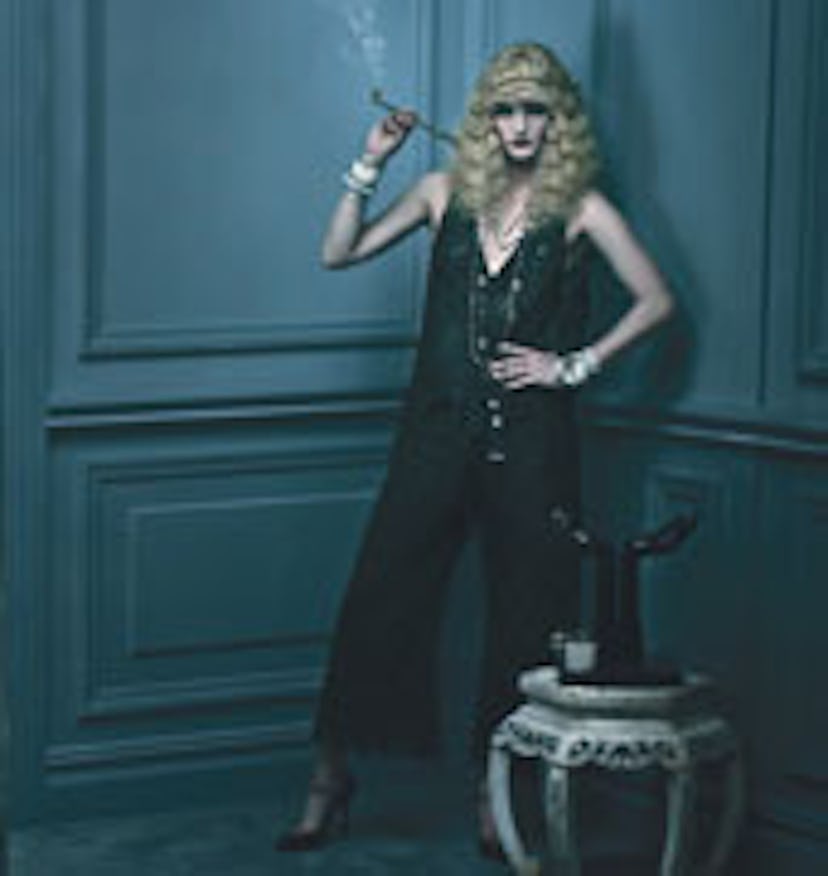One for the Ages

In just two years, Phoebe Philo has transformed Céline into the ultimate insider label. Pairing her own work with the images that inspire it, the reclusive designer opens up to Tim Blanks about her creative process.
1
“There’s always a sense of street culture in my work,” Philo says of the model in an oversize masculine leather coat and drainpipe pants, and the girl with a mullet who might have been plucked from a Suzi Quatro concert circa 1974. “Most street trends are British, and I’m very, very proud to be British. I like the sense of belonging here.” British tribalism—in particular, that of the streets of West London, where she grew up—has always influenced Philo. As she says, “Finding a uniform, a place to fit in, a clan you identify with—you wear the same clothes, you listen to the same music, go to the same clubs. It’s that period of leaving home and finding your own family.” Philo has been able to transfer that sense of exclusive inclusiveness to Céline.
Céline’s leather coat, wool and leather pants, and shoes from fall 2011.
2
Street culture is also infected with the germ of rebellion, which is why the women in Philo’s visual lexicon are so often tough, tomboyish, and anchored to the earth by no-nonsense footwear. “I find that very attractive,” she says. “They’ve got their feet on the ground. I can sometimes find the image of a woman in an extreme high heel exciting, but I also love practicality. I can relate to being completely in control of what you need to get done.” Is that a British trait? “I’m not sure it is anymore, but I think we’re quite a practical bunch. I like when you see the Queen or Princess Anne in the same outfit 15 years later. There’s a fine line between feeling new and contemporary, and at the same time creating something I hope I’ll still be wearing in 10 years.”
Céline’s cotton poplin and chambray denim shirt from prefall 2011 and wool and leather pants from fall 2011.
3
In that light, the androgynous essence of Céline is intriguing—and crucial to Philo’s aesthetic. She was excited by the idea of putting boots that remind her of a Prussian officer next to a Céline piece that has the lean, tailored lines of the coat one might imagine that officer wearing. “I like androgyny in my clothes, in the faces of the models wearing those clothes, and even in their body language,” she says forcefully. “I also find men’s wear and the fact that men usually have a set uniform very inspiring—there’s something liberating in not having too many choices. Maybe that’s something women are responding to in my work.” Philo clearly practices what she preaches. For our interview, she wore a masculine white shirt, straight pants, Adidas’s Stan Smiths, and a gray sweater tied scarflike around her neck.
Céline’s wool and leather coat and cotton turtleneck from fall 2011 and silk pants from resort 2012.
4
Being direct in the way she dresses, Philo says, even shapes her standards of beauty. The models she chose here, for instance, are determined in their engagement with the camera. She talks about her own determination “to do the thing that’s right for me, for Céline, and for women.” As passionate as those words sound, they’re delivered in a quiet, measured tone that hints at the inner steel that has allowed Philo to achieve so much at the relatively young age of 37. There is, however, one last point to mull over. When asked with what image she would pair the serious, slightly forbidding portrait of herself that opens this story, Philo selects a surreal photo of pink flamingos in the snow. They’re clearly hardy birds, but there is also something quintessentially fragile about them. Philo, it would seem, keeps her secrets after all.
From left: Céline’s wool dress with leather panels from fall 2011. Céline’s cashmere and polyester sweater from fall 2011 and cotton poplin shirt from prefall 2011.